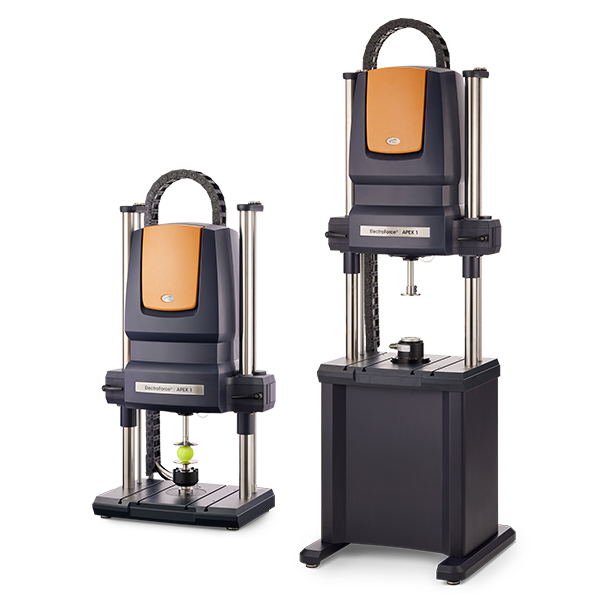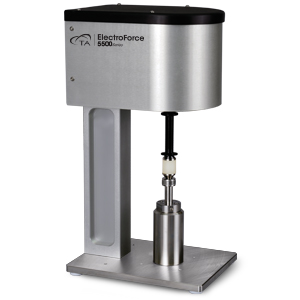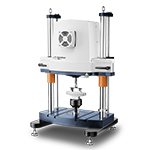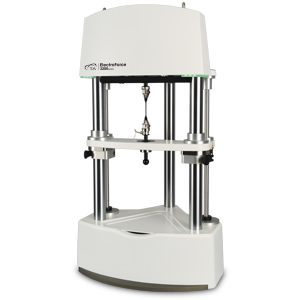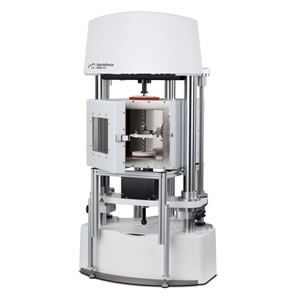View Rubber Brochure Rubber Accessories Request a Quote
Dynamic Mechanical Analysis measures the mechanical properties of materials as a function of time, temperature, and frequency. In addition to quantifying viscoelastic properties of materials, DMA’s and especially High-Force DMA instruments can also quantify finished component and product characteristics, reflecting the important contribution that processing has on end-use product performance. DMA is commonly used to measure glass transition temperatures and secondary transitions, orientation caused by processing, cold crystallization, cure optimization, filler effects in composites, and much more. DMA provides an accurate measure of material modulus and product stiffness plus other important mechanical properties such as damping, creep, and stress relaxation. High-force DMA extends the powerful DMA techniques to higher forces, larger oven sizes and larger sample fixtures to provide viscoelastic characterization of samples that should not be miniaturized as well as measuring components, assemblies or complete products.
A Dynamic Mechanical Analyzer is a mechanical instrument that applies specific displacement or force to a sample and very accurately quantifies its force versus displacement response. DMA measurements extend beyond simply quantifying the magnitude of force divided by the displacement magnitude; it accurately calculates the phase relationship between the signals. This enables a DMA instrument to quantify the elastic (spring-like) versus viscous (fluid-like) components of the sample response which is crucial for reliable and complete viscoelastic property characterization such as Storage Modulus, Loss Modulus, and Tan delta. These viscoelastic properties are almost always evaluated over a range of temperatures using oven and cooling accessories, which then can provide many insights into structure-property relationships and how materials perform at different use temperatures. Some advanced methods include TTS (Time-Temperature Superposition), curing studies, creep-recovery, and stress-relaxation analysis.
TA Instrument’s High-Force DMA series ranges from 500 N to 15,000 N of force capacity. They build upon TA’s reputation and capabilities in Dynamic Mechanical Analysis and often work side-by-side with the DMA 850 or RSA-G2 lower force instruments. With very powerful and dynamic ElectroForce linear motors, they execute demanding oscillation DMA control, plus offer ultra-reliable fatigue test capability. These High-Force DMA instruments extend the insights revealed by DMA to higher forces and sample sizes, providing valuable insights when materials cannot be miniaturized or for components or products that are larger in size. A wide range of instrument capacities and environmental control options are available to best match virtually any application requirements.
The following ElectroForce instruments can be configured for Dynamic Mechanical Analysis including Temperature Analysis.
| Model | Maximum Force (N) | Max DMA Frequency (Hz) | Temperature Range (C) |
| DMA 3200 LSO | 500N | 100Hz | -150 to 315°C |
| DMA 3200 FCO | 500N | 100Hz | -150 to 600°C |
| 3300 | 3000N | 75Hz | -150 to 350°C |
| 3510 | 7500N | 40Hz | -150 to 350°C |
| 3550 | 15000N | 35Hz | -150 to 350°C |
The following ElectroForce instruments can be configured for Dynamic Mechanical Analysis at ambient or 37C temperature.
| Model | Maximum Force (N) | Max DMA Frequency (Hz) | Temperature Range (C) |
| 200N TestBench | 200N | 75Hz | Ambient air or 37°C fluid |
| 200N Planar Biaxial | 200N | 75Hz | Ambient air or 37°C fluid |
| 5500 | 200N | 15Hz | Ambient air or 37°C fluid |
Common Testing Standards
- ISO 4664 – Rubber, vulcanized or thermoplastic — Determination of dynamic properties
- ISO 4666 – Rubber, vulcanized — Determination of temperature rise and resistance to fatigue in flexometer testing
- ISO 6721 – Plastics — Determination of dynamic mechanical properties
- ASTM D623 – Plastics DMA: Standard Practice for Plastics: Dynamic Mechanical Properties: Determination and Report of Procedures
- ASTM D4065 – Plastics DMA: Standard Practice for Plastics: Dynamic Mechanical Properties: Determination and Report of Procedures
- ASTM D4473 – Standard Test Method for Plastics: Dynamic Mechanical Properties: Cure Behavior
- ASTM D5023 – DMA testing: Standard Test Method for Measuring the Dynamic Mechanical Properties: In Flexure (Three-Point Bending)
- ASTM D5024 – Standard Test Method for Plastics: Dynamic Mechanical Properties: In Compression
- ASTM D5026 – Standard Test Method for Plastics: Dynamic Mechanical Properties: In Tension
- ASTM D5418 – Standard Test Method for Plastics: Dynamic Mechanical Properties: In Flexure (Dual Cantilever Beam)
- ASTM D5992 – Rubber testing: Standard Guide for Dynamic Testing of Vulcanized Rubber and Rubber-Like Materials Using Vibratory Methods
- ASTM D7028 – Standard Test Method for Glass Transition Temperature (DMA Tg) of Polymer Matrix Composites by Dynamic Mechanical Analysis (DMA)
- ASTM E1640 – DMA testing: Standard Test Method for Assignment of the Glass Transition Temperature By Dynamic Mechanical Analysis
- DIN 53513 – Determination of the viscoelastic properties of elastomers on exposure to forced vibration at non-resonant frequencies
- DIN 53533 – Testing of elastomers; testing of heat generation and service life during the fatigue test
Mechanical Fatigue & Dynamic Mechanical Analyzers
Application Notes
- Dynamic Testing Characterizes Frequency Dependence of Liver Tissue
- Viscoelastic Characterization of Agarose Gel Scaffolds
- Quality Assurance of Bose® SoundLink® and SoundLink Mini Passive Radiator Materials
- Dynamic Testing Predicts Success of Nanocomposites
- Tire Cord Dynamic Properties Measured for FEA Model
- Automotive Fatigue Life and Dynamic Mechanical Analysis of a Matrix Polymer
- Generation of Master Curves for Cured Rubber
- Dynamic Testing Uncovers Rheology of Rubber
- Evaluating Fatigue Characteristics and Heat Generation in Silica ‘Green Tire Recipe’ and Conventional Carbon Black Filled Rubber
- Characterizing Hydrogels using Dynamic Mechanical Analysis Methods


